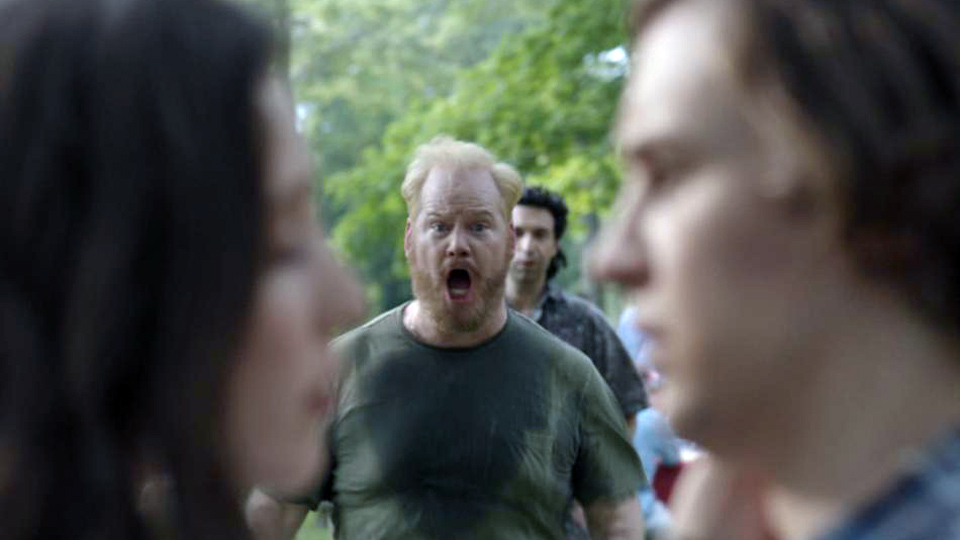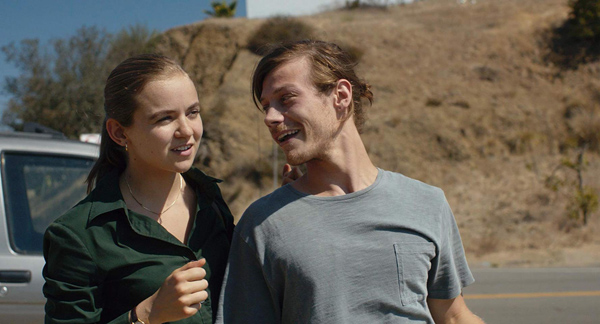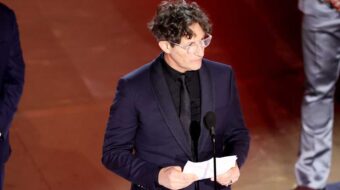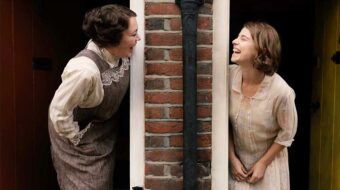
LOS ANGELES—Two films premiered at the LA Film Festival this past week having to do with families, which is familiar territory for the cinematic art.
We the Coyotes, directed and written by Hanna Ladoul and Marco La Via, received its North American premiere Sept. 26, with members of the cast and crew fielding a Q&A afterward. The filmmakers are a mixed French and American team. The French have a longstanding admiration for American film, so the day would certainly come when they would take on an equally familiar subject on their terms, the iconic journey to Los Angeles to set up a new life.
In You Can Choose Your Family, a first feature film by Miranda Bailey, in its L.A. premiere the same date, Frank, a ketchup manufacturer, got involved as a young man with two girlfriends who both became pregnant. Rather than “man up” and deal honorably with himself, with the women and with the situation he has created for them, he takes the unusual step of setting up two entirely different households and families. It’s a rather more original conceit than Coyotes. This film takes place in the 1990s.
A magical, tragical first two days in L.A.
Jake (McCaul Lombardi) and Amanda (Morgan Saylor) are first seen in their beat-up ’98 Nissan Pathfinder on the I-10 West heading from Chicago into L.A., excited, anxious, youthful, hopeful, oblivious, listening and singing along to rap recordings as they barrel into town. First stop, Tarzana, an upscale neighborhood, where they crash (in separate bedrooms) with Amanda’s aunt Jeanine (Betsy Brandt) for one uncomfortable, judgmental night. It seems Amanda’s family is not too keen on the sketchy, tattooed, tumbleweed-haired Jake, whose prospects appear to be unsuited to an educated, accomplished young woman. The only other person they know in town is Jake’s old bud Danny, or D-Boi (Khleo Thomas), a rapper who’s trying to claim a foothold in the music world. He has a self-produced CD or two out, but at the moment he’s saving up his money by living in his car.
After these disappointing first contacts, Amanda has a promising interview at a record company. She has some administrative background already, and the interview with the two hip employers goes well enough. They offer her the job—but it’s un unpaid year-long internship (with free parking and a gym membership!), which she refuses. “Young people can’t afford to work for free,” she scolds them pointlessly, because their next applicant will likely take the position.
The couple are on the point of despair, and totally out of money, but their spirits lift when they attend a fun house party that night where D-Boi and other artists are performing. Maybe there’s some way Amanda and Jake can create a new life for themselves here after all.
The film includes many lyrical interludes of discovery—the beach, the ocean, Hollywood, the freeways, Griffith Park, the leafy walk streets of Venice—as the pair drive around the vast and not-so-inviting city. Coming so close on the heels of the film La La Land, which mercifully did not win the Oscar for Best Picture, Coyotes is a love letter to L.A., which has been so good to so many people in “the Biz.”

The title refers to the prowling coyotes seen in Griffith Park, where Amanda and Jake and their newfound party friends have spent the night—restless, predatory animals thriving on the outskirts of civilization, waiting to set their teeth into a tasty, unattended house pet, or possibly, if there’s a pack of them, into a defenseless person (though such reports are never heard). Having seen how cruel the world can be—most of it legal and legitimate, if shady and disreputable—we would think the title refers to those who exploit the naivety and inexperience of normal people trying to make the best of their lives. But we are coyotes, too, apparently: We too fight for our survival on the fringes of society. The more usual definition is, of course, the unscrupulous men immigrants pay to lead them through the desert and over the border into the U.S.
Normally I am more attentive to the socio-political-economic content of the works I write about than to the artistic niceties, and that is true so far with this review. But I cannot refrain from stating my amazement that in a film about bright, sunny L.A., the colors in so many passages are dim, murky and muddy. I thought at first that it looked like it hadn’t received its final color correction, but I can only surmise that the cinematographer (Stephen Tringali) wanted to say that L.A. is not necessarily the city of sunshine and bright lights that hundreds of other films make it out to be. It reminded me of Cold War films where the scenes set in Eastern Bloc countries were always filmed on gray, depressing days. By contrast, the night scenes are all invaded by the overly trendy bokeh effect, which makes colorful circles out of lights in the background using a shallow depth of field. Weirdly, a lot of this film simply doesn’t look good.
In the end, the old cliché “The kids are gonna be all right” rose up to my consciousness from a shallow recess in my brain.
Now why is this a film about families? The ones we left behind back East are dysfunctional and toxic (the story of America, right?). The ones we create for ourselves are more meaningful and sustaining.
Can you actually choose your family?
I wondered if “You Can Choose Your Family” would have been a more appropriate title for the film reviewed above, instead of this one. It’s unclear who the “you” is in the title. Nor does the film establish that anyone in this film gets to choose anything, except Frank, who chooses two families—unless you break out on your own, or with your partner, and make a new life for yourself.
Frank (Jim Gaffigan) has set up two upscale households in the greater Detroit area (the inner city is nowhere seen). In one home, his wife Laura (Anna Gunn) reads The Sexual Politics of Meat and tries to be a good mom to 17-year-old college-bound son Philip (Logan Miller), from whose eyes we see this picture, and to their younger daughter Lib (Emerson Tate Alexander). (Not to overstate this, but might “Lib” symbolize for the next generation a greater freedom and agency for women?) Here Frank feels constrained, Laura seems dutiful if not content, and the kids are subjected to petty management. It’s like here Frank is supervising his ketchup plant. There’s little fond bonding with this set of family members.
In the other home, out by the lake (the geography in this film remained a little unfocused), everything’s quite different. Here Frank is genuinely in love with Bonnie (Samantha Mathis), a semi-professional painter, and that emotion spreads to their two gorgeous children, Eddie (Gage Polchlopek) and daughter Kelly (Isabelle Phillips), whom he supports and encourages generously and without all his other persona’s martinet rules. It’s not clear whether Frank and Bonnie had ever legally married (or illegally, actually, since he was already married).
Philip has a sidekick Lewis (Daniel Rashid), with whose bong-addled lowlife uncle Ross (Alex Karpovsky) they stay, so they can be closer to the classy teenage pool and party scene out by the lake. And that’s where the shocking discovery is made: Philip’s father Frank has this whole other family out there!
Much of the rest is clever plotting that involves all the little and big fictions that have kept these families two separate entities for almost twenty years. Can the pretext be maintained? Once he discovers the truth, can Philip be sworn into the father-son secret pact in exchange for his NYU tuition? Are (half-siblings) Philip and Kelly developing romantic feelings? Will Uncle Ross ever straighten out sufficiently to be a useful member of society? And what’s the story with Lewis—is he gay or not?
Frank is a deeply flawed character—everyone except maybe Bonnie seems to think he’s pretty much a dick. But it’s a comedy, so he’s also kind of lovable, well, at least likable. In the big reveal to Philip, he admits he made a series of poor judgments over the years, but they seem, at least structurally if not realistically, understandable. We are not entirely unsympathetic to him.
The entire film shuttles back and forth between the toney suburbs and the lake community, all very bourgeois. Few are the scenes which show the characters outside these environments: One is with Laura and Lib who are painting protest signs for a demonstration. But Frank is never seen in the work environment which has enabled him to sustain these two families, and that might have shown us what kind of owner, manager, or friend he was. If an SOB of a boss, that would tell us pretty much all we’d need to know; if he showed some kindness to his employees, we might have seen him in another light.
There are many attractive features to this film, and it’s worth seeing mostly for the really good acting, but it also requires far more than the usual pinch of disbelief in need of constantly reinforced suspension, like an old-fashioned European comedy of manners or a Feydeau farce. Set in the 1990s, before social media would have exposed Frank’s hoax much, much sooner (if he could have gotten away with it at all), still it hardly adds up logically. Back in the 1990s there were postcards that might have been sent back from Japan, gifts and souvenirs brought home, telephone calls during those absences, receipts, trips to airports, occasional invitations to the wife or kids to join him, etc. How could he be a half-time husband in two households and no one particularly notices?
The film asks for understanding, if not forgiveness. It must have been a delicate challenge to get the script (Glen Lakin) right. As a gay writer, he said in the post-screening talkback that mostly featured the director and Jim Gaffigan, he spoke about teenagers, as part of their coming of age, “realizing that adults have to make difficult decisions.” Director Miranda Bailey referred obliquely to personal issues in her life that the film addresses. In the process of making this film “about family and forgiveness,” she said, “naivety was very helpful.”
It’s important to remember that ultimately the film is about growing up Philip, because otherwise we’d be too deeply offended that Frank gets off so lightly for his misbehavior, which would seem antithetical, especially from a woman director. We don’t really know what will become of his two wives, but as in Film #1, the resilient kids will apparently turn out OK.












Comments